In early April 1982, Argentina invaded the Falkland Islands, a few desolate rocks in the South Atlantic. The British mobilized their fleet in response. The carriers arrived off the Falklands on May 1st, swiftly defeating the Argentine Air Force. The Argentine Navy tried to interfere the next day, but withdrew after the cruiser General Belgrano was sunk by a submarine. Two days later, the Argentinians struck back, sinking the frigate Sheffield with an Exocet missile. Two weeks later, on May 21st, British troops landed at San Carlos Water on the west coast of East Falkland. The Argentine Air Force quickly got wind of this, and launched numerous sorties against the invasion fleet. The first three days were brutal for both sides, with the British losing two frigates and suffering several others damaged, while a third of the Argentine jets were shot down. May 24th saw the only serious attack on the amphibious shipping, followed by a last strike on the 25th.1
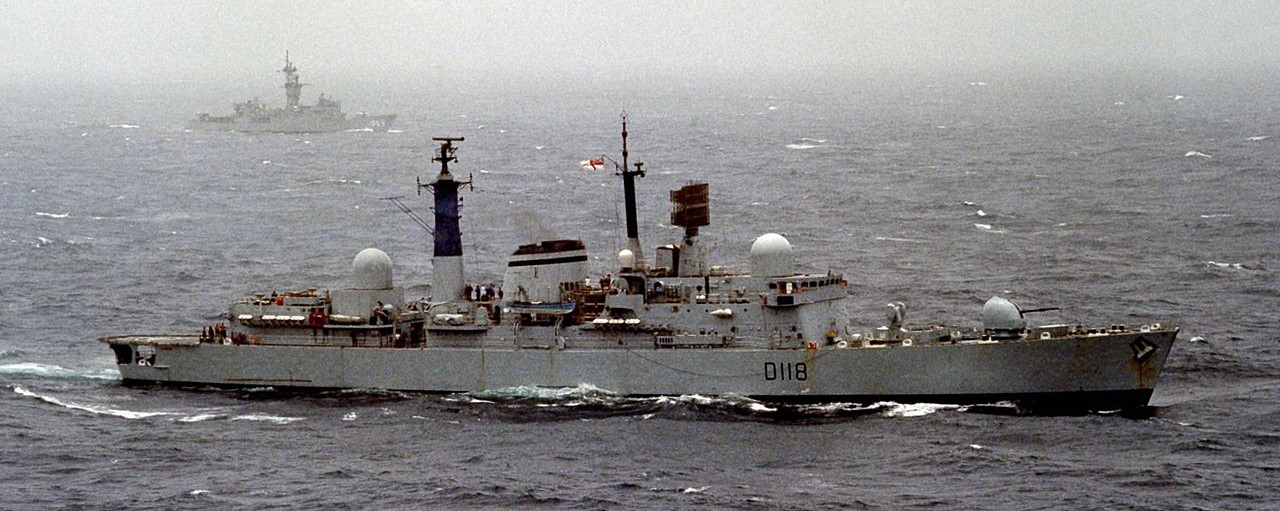
Coventry
In an attempt to stem the tide of air attacks, the destroyer Coventry and frigate Broadsword had been stationed to the north of Falkland Sound, serving as a "missile trap" and directing the Sea Harrier Combat Air Patrol (CAP). On the 24th, they had vectored in Sea Harriers that had shot down three aircraft from a four-plane raid, while the morning of the 25th saw two Skyhawks fall to Coventry's Sea Dart missiles. The Argentinians were well aware of their presence, and at 1300 on the 25th, they sent a flight of six Skyhawks after the ships. Two had refueling problems and had to return to base, but the other four bored in. They came to the south of West Falkland, and the British assumed that they were headed for San Carlos from the south. Instead, they turned north to cross West Falkland, dodging the CAP dispatched on the assumption they would keep heading east.
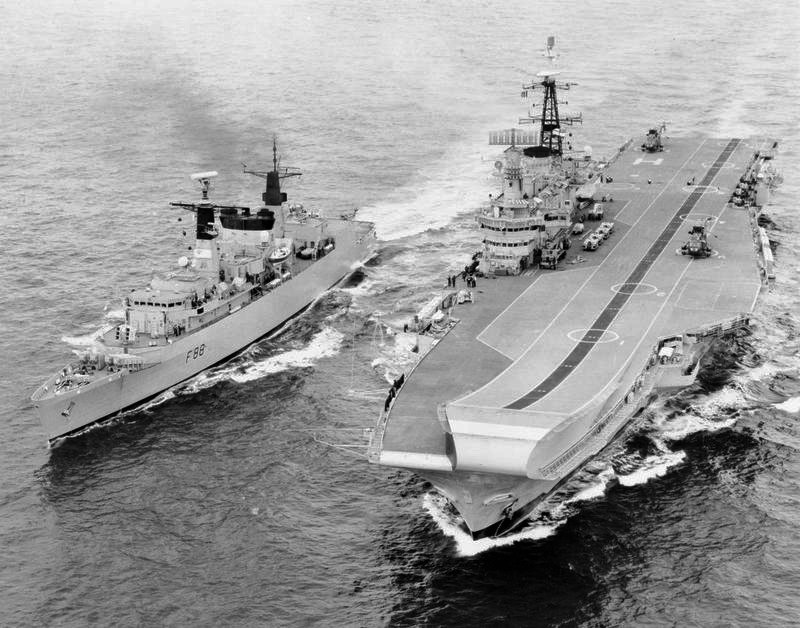
Broadsword escorting Hermes
One pair was picked up again over West Falkland, and the northern CAP was well-placed to intercept. The two Harriers dived in, but were ordered off by Coventry's Captain, David Hart Dyke, as they would only reach firing range moments before the attacking jets entered the envelope of the destroyer's Sea Dart. Dyke was concerned that the Sea Darts might accidentally home in on the Harriers, and confident in the efficacy of his ship's systems.
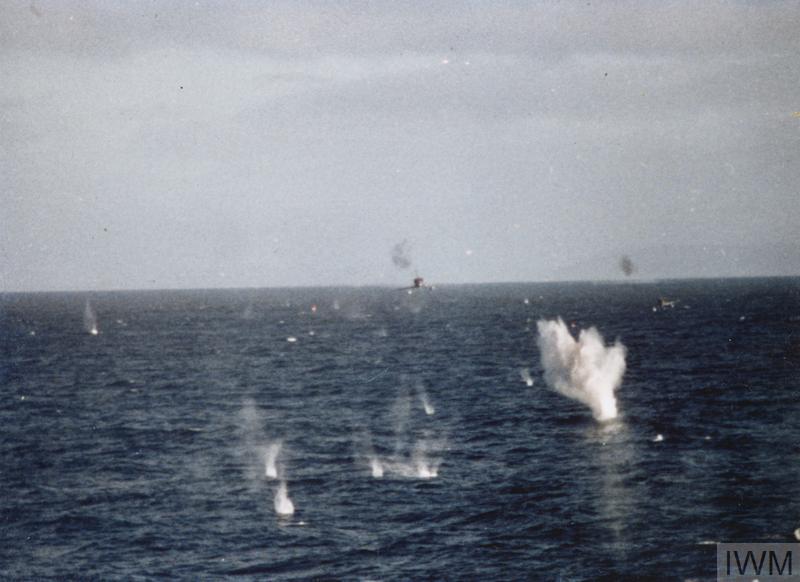
The first pair of Skyhawks attack Broadsword
Tragically, his confidence was misplaced. Despite being guided by a datalink from Broadsword, Coventry's systems failed to pick up the Skyhawks as they approached the two ships, leaving the destroyer with only her gun to protect herself. Broadsword readied her Sea Wolf, but just before the missiles were to fire, it too locked up and the launchers slewed back to their fore-and-aft positions. The Skyhawks, flown by Air Force pilots unused to attacking moving ships, initially aimed for Coventry, but were forced to attack Broadsword instead. Three of their 1,000 lb bombs missed, while the last one fell short and ricocheted off the sea, passing through the frigate's side and up through the flight deck, wrecking a Lynx2 and then falling into the sea without exploding.
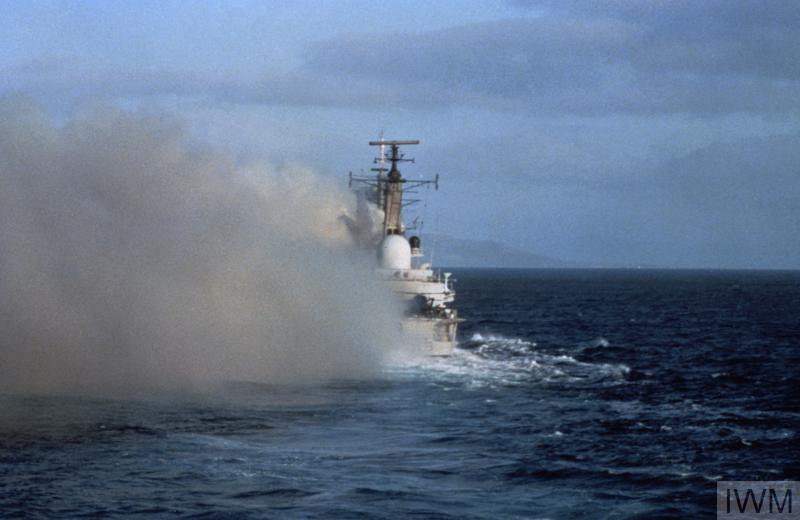
Coventry aflame just after the attack
As the first pair of Skyhawks escaped, the second appeared to the southwest of the British ships, with the CAP in pursuit again. As before, Dyke ordered them off, but the Sea Dart again failed to acquire. Coventry attempted to disrupt the attackers by firing a missile blind, but it passed 300 yards clear of the incoming jets. The destroyer turned to give Broadsword a clear shot, and the frigate's point-defense missiles had a good lock as the Skyhawks bored in. Unfortunately, Broadsword failed to match Coventry’s maneuver, and just before the Sea Wolves were going to blot the attackers out of the sky, Coventry got between her and her targets. The engagement had to be aborted, and unlike the previous pair, the pilots of the Skyhawks, Mariano Velasco and Alférez Barrionuevo, delivered a textbook attack, hitting the luckless destroyer with three of their four bombs. The low-level attack should have kept the fuzes safely inert, as it had for so many bombs, but in this case, they functioned perfectly, detonating in Coventry’s machinery spaces at 1419.
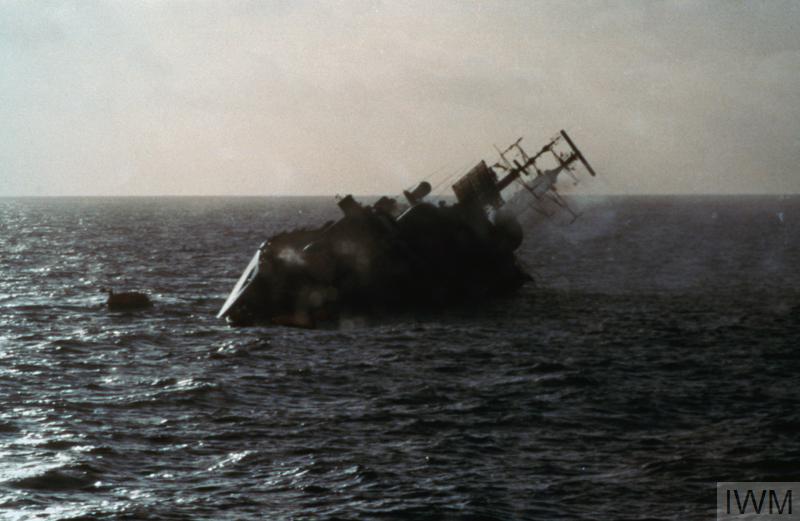
Coventry listing
The explosion opened the destroyer's side, and she began to heel almost immediately. Smoke filled the ship, and it was obvious that she was doomed. The order was given to evacuate, and despite the smoke and heel, only 19 men of the 189 aboard went down with Coventry. Within 15 minutes, she was on her beam ends, and she soon sank to the bottom of the South Atlantic.3
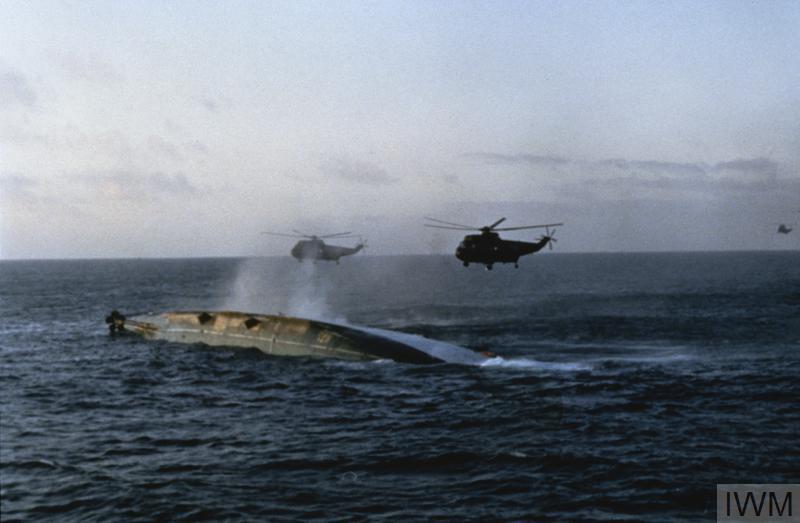
Helicopters move in to rescue survivors near Coventry's capsized hull
Coventry's destruction wasn't the only blow the British were to suffer on the 25th. VYCA-2, the Argentine air-control group at Port Stanley, had been tracking the Harriers since the beginning of the war. This data was usually used to help incoming air raids avoid the CAP, but in theory they could also track the Harriers back to their point of origin. This was the only real way to find the fast-moving carrier force now that the P-2 Neptunes had all broken down, although the British were aware of their vulnerability and often took measures to fool the Argentinians. These had worked well enough on the 23rd, but on the 25th, conditions were good and at 0800 VYCA-2 passed a position to the mainland that was only 5 nautical miles from where the carrier Hermes actually was at the time.
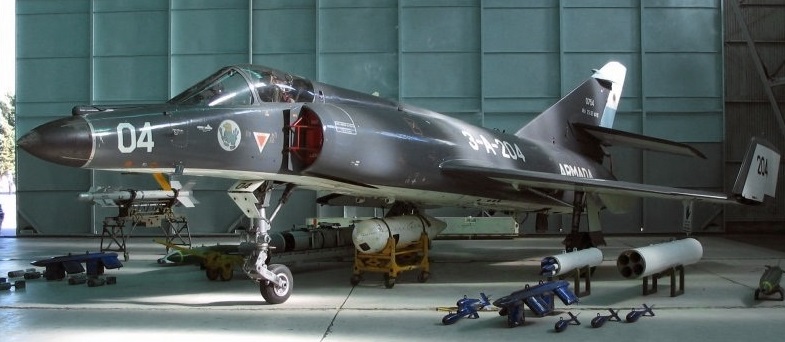
An Argentine Super Etendard
The orders for the strike went to the Argentinian Navy's Super Etendards, French-built attack aircraft that had been intended to modernize their carrier-based airforce. They were armed with Exocet antiship missiles, although only five had been delivered before France embargoed any military aid to Argentina at the outbreak of war. Two had been used to sink the destroyer Sheffield in early May, but that still left three to threaten the carriers with. Unfortunately for Argentina, while the two Etendards were ready to take off by 1000, they would need tanker support, and the only available tankers were supporting the Skyhawks already in the air. It would be another three and a half hours before they could fly.
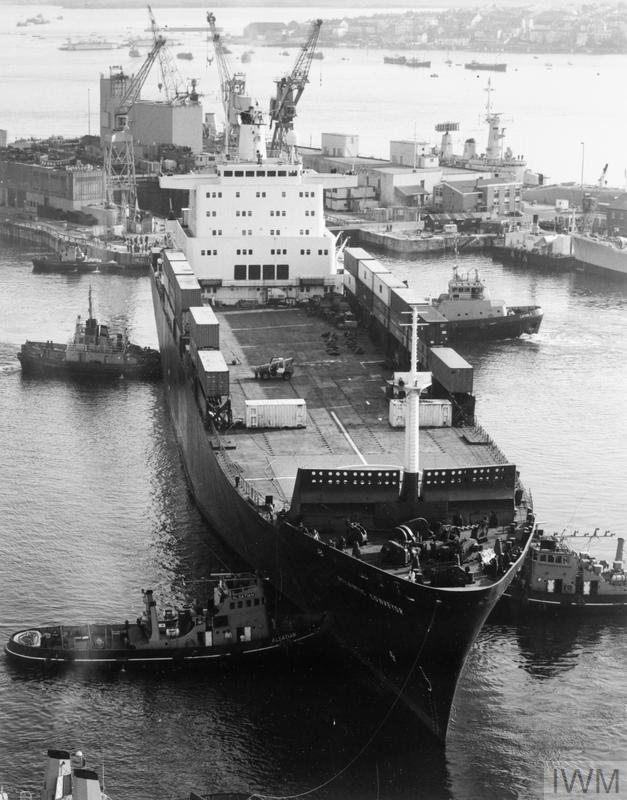
Atlantic Conveyor leaving Devonport after her conversion
The Super Etendards refueled to the north of the Falklands, allowing them to approach the carriers, which had closed in to within 60 miles of Stanley to cover the arrival of SS Atlantic Conveyor, from an unexpected direction. Atlantic Conveyor was one of the many "Ships Taken Up From Trade", and she had already done the vital work of bringing extra Harriers south to reinforce those on the carriers. They had all been flown off, but still aboard were six Wessexes and four Chinooks, which would provide mobility to the landing force in the rugged terrain of the Falklands. These had been flying for several days, greatly easing the strain on the Task Force's other helicopters, but facilities to support them were still being assembled ashore. Belowdecks were supplies ranging from 75 tons of cluster bombs to a complete field camp including tents, kitchens and laundry facilities for 4,500 men. Despite her value, Atlantic Conveyor, like the other STUFT, had been left with no defensive systems due to the press of time and questions about the legality of arming her.
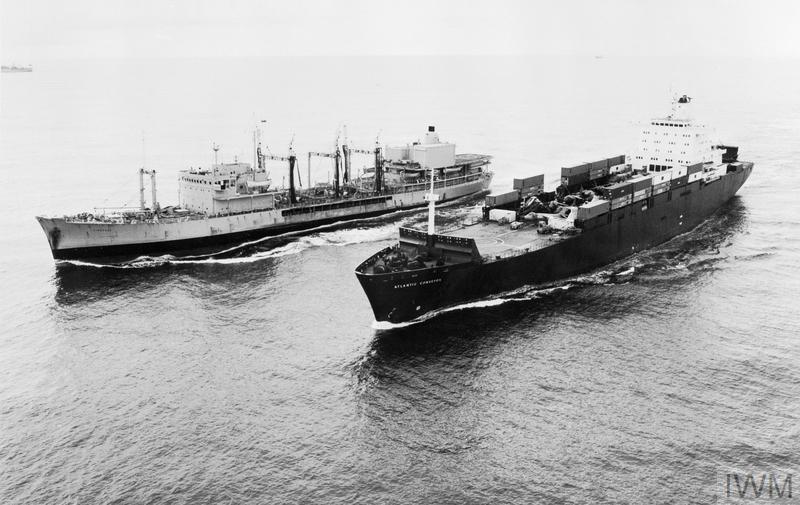
Atlantic Conveyor refuels from RFA Tidepool
At 1536, the two Argentinian aircraft popped up and began sweeping for targets. Unlike their response three weeks previously, the British quickly picked up the radar and sent the alert to the group. The pilots saw only two large and one small blips, namely Atlantic Conveyor, Sir Tristam and Ambuscade, despite being a mere 40 miles from Hermes. The Etendards themselves were also detected and tracked, but before the British could take action, both Exocets were launched and the Argentine jets turned away. The British immediately implemented their Exocet drills, firing chaff and turning to either maximize their defensive firepower or minimize their radar signature. Both missiles were successfully drawn off by Ambuscade's chaff cloud, but one flew through and picked up Atlantic Conveyor. The hapless merchant ship had no defenses, and the Exocet struck the port quarter. It's not entirely clear if the warhead went off, but fire soon spread through the vehicle decks.
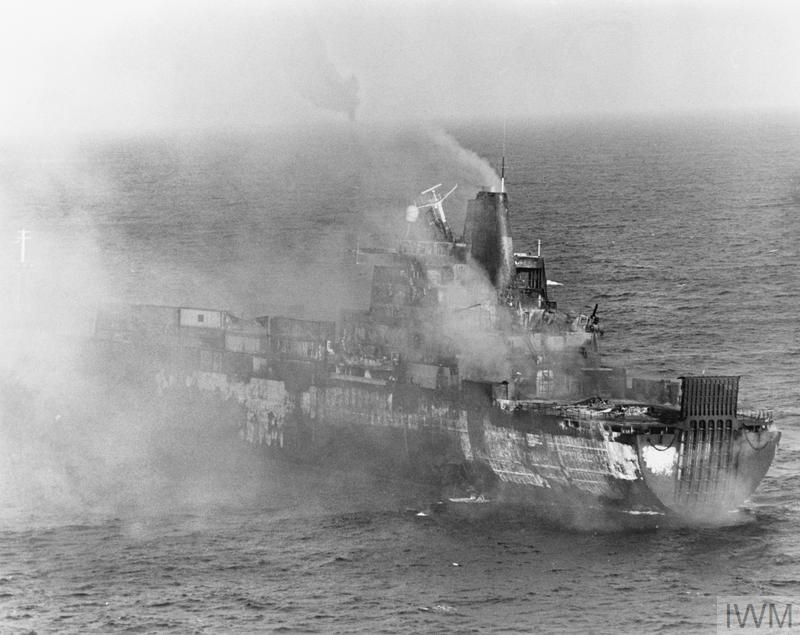
Atlantic Conveyor burns after the Exocet hit
Almost immediately, it was clear the ship was doomed. Her compartmentalization and firefighting were not to military standards, and within 10 minutes of the missile hit, she was without power or water pressure, leaving only portable pumps to fight the fire. By 1615, the fire was approaching the cluster bombs, and the decision was made to abandon ship. Most of the men were aft, and they climbed down a ladder into the liferafts. Getting from the ladder into the rafts was hazardous, and several men, including Atlantic Conveyor's master, Ian North, were lost in the process. Thirteen men trapped on the flight deck were rescued by one of the Sea Kings from Invincible. The frigate Alacrity rescued most of the survivors in the rafts, but a few were plucked from the water by a Sea King flown by Prince Andrew.4 In total 12 men were lost out of 162 onboard at the time. Atlantic Conveyor herself would remain afloat for another three days before sinking while under tow.
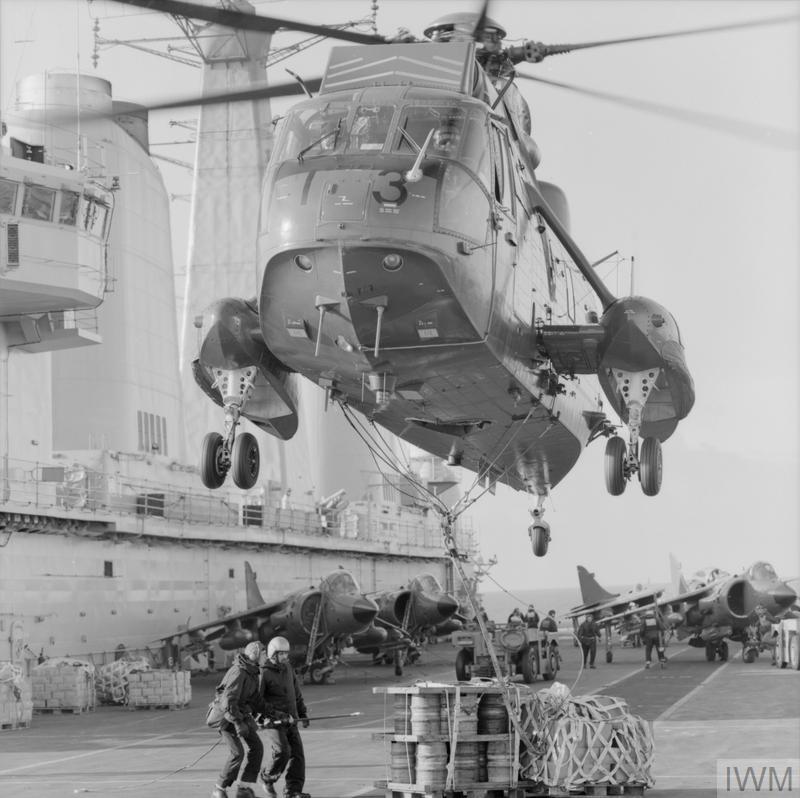
A Sea King of 820 Squadron, Prince Andrew's unit
The loss of Atlantic Conveyor was by far the worst blow suffered by the British during the war. The helicopters necessary to create an airmobile force were now on the bottom of the Atlantic, forcing the ground troops to march across the island. One Wessex had already been flown ashore, and a single Chinook, known as Bravo November, was airborne when the missile hit. It landed on Hermes, and despite a complete lack of tools, manuals, or spare parts, played a vital role in the ground campaign. Other losses were also serious, including runway material and fuel systems for the San Carlos area, and the tents, whose loss was felt by the Argentinian POWs just as much as the British.
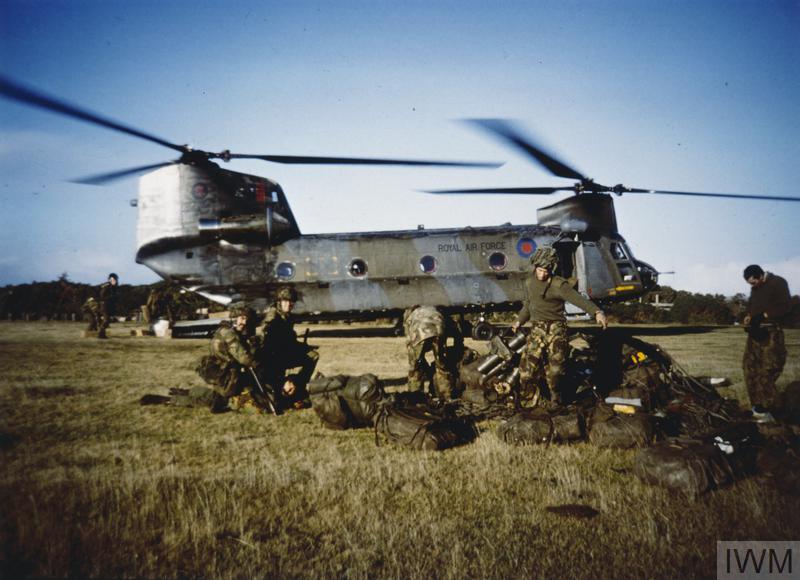
Bravo November in the Falklands
Despite their losses, May 25th saw the British begin operations to break out from San Carlos. Glamorgan and Plymouth bombarded Argentine positions ashore, while Fearless reconnoitered Teal Inlet, where the ground forces would build a forward base to allow them to assault Stanley. At dawn the next day, they would begin to move, and we'll pick up the story there next time.
1 For more information on ships and aircraft, as well as links to the whole series, see my Falklands Glossary. ⇑
2 The Lynx actually belonged to Brilliant, whose other helicopter had been lost to strafing damage on May 21st, also aboard Broadsword. ⇑
3 An interesting footnote to the whole affair is the Cross of Nails, made from nails of the old Coventry Cathedral, destroyed in the Blitz. It was recovered by divers, along with various pieces of classified material, and subsequently carried by the next HMS Coventry and today by HMS Diamond, associated with the city. ⇑
4 The Prince was serving as a Sea King pilot before the war, and was sent south with the Task Force. The MoD was nervous about putting a member of the royal family in harm's way, and tried to move him to a desk job before the Queen intervened and stopped them. He also is known for flying Exocet decoy missions, although I don't think the claims that he was on one when Sheffield was hit make sense, as they didn't know the Exocets were operational at the time. ⇑

Comments
...IIRC, some Argentinian sources still insist they sank HMS Invincible instead of Atlantic Conveyor. Some of the online articles about this are comedy gold.
Do we have reason to suppose that a modern naval war would feature equipment that actually works. Or would it be a repeat of this story?
@Mike
I really should find and mock some of those. Also, you've given me an idea...
@doctorpat
We've gotten somewhat better at testing these kind of things since then. I won't say there won't be these kind of issues, but there will hopefully be fewer of them.
@bean
I really want to thank you for this Falklands series. As an 80's child, my knowledge of the war was produced from offhand references several years after the fact, and heavily skewed towards a picture of unremitting British dominance. Your series has shown that the war was a somewhat slapdash affair and could have been extremely costly for the UK had the circumstances been slightly different. (Argentina had 10 exocets instead of 5, or better naval bombing fuzes as examples)
In particular for me the series has been a warning against complacency. It is very easy in the modern world to think of military advantages being overwhelming (Thanks, Desert Storm) and it is important to see that even a numerically and technologically superior force can be in danger without exhaustive testing and training in real-world scenarios.
You are most welcome. It's been interesting to write, and I've certainly learned a lot about the Falklands by the process of understanding it well enough to write about it.
This is actually a really interesting way of looking at it. The British dominance certainly wasn't unremitting, but at the same time, given the huge difference between what they had planned/trained to do and what they did, it's deeply impressive how well they performed.
I suspect that it comes across that way some times because the Argentinians did not have any sort of decisive action that failed – no Waterloo, as it were – and so if you have a cursory knowledge of the war, it seems basically like the British invasion fleet showed up and took the islands back, and the Argentinians just sort of harassed them.
The impression I've gotten from this series, Bean, is that the Argentinian's main failure was a failure to follow up on their conquest and prepare the Falklands for an invasion. As it is, it seems like their air force, at least, performed much better than anticipated – not so much for the surface navy or army, though. Do any of your sources compare the total cost of assets lost on both sides?
My understanding is that the junta believed that the British wouldn't contest the occupation, giving them a quick and easy victory. They took some effort to avoid causing casualties to the garrison during the invasion, presumably to make it easier for the British to back down. The UK refused to accept it as a fait accompli, and the Argentinians never really decided whether to give up, or go all in.
To be fair to the Argentinians, I'm not sure what going all in would have involved - possibly the loss of their carrier and more casualties to their professional soldiers, if used in the defence of the islands, and admitting that they'd made a mistake in invading can't have been easy either. Once they'd set things in motion, how could they have managed a better outcome?
“Once they’d set things in motion, how could they have managed a better outcome?”
One answer that comes to mind is to have rapidly improved the defenses of the Falklands proper. Most of what bean has been describing, has involved Argentine aircraft flying at the extreme edge of their combat radius and under severe fuel constraints; if they’d been able to fly serious combat aircraft from the Falklands, and in particular if they’d been able to fly their own combat air patrol over the islands, the Royal Navy would have had a much more difficult problem. The existing runway at Port Stanley wasn’t long enough for e.g. Mirage fighters, but techniques for rapid runway construction were well known. Whether the FAA (Argentine air force) would have been able to pull it off in a month is an open question.
Also on that front, the FAA had only five air-launched Exocet missiles, but the ARA had a much larger number of surface-launched versions, including spares for reloading the launchers on their warships. Two of those were prepositioned on the islands, and during the war some enterprising Argentine technicians improvised a shore-based missile battery (I’m sure Bean will be telling that story), but if this had been planned from the outset the effects could have been more telling. Particularly insofar as the ARA never actually used any of their Exocets in ship-launched mode. 155mm howitzers coupled with surface-search radar and some hasty training in engaging ships at sea would also have made things difficult for the amphibious force in particular.
Finally, the ARA needed a clear doctrine on how they were going to use their fleet against the British. Starting with, were they going to deploy a carrier task force against the British? “No” is a reasonable answer, but in that case you don’t task your two modern destroyers with escorting that carrier while sending your one cruiser to sea with only a couple of WW2 rejects as escorts.
But the real answer is, once they had set things in motion it was probably too late. The right move, if it had been politically feasible in Buenos Aires, would have been to spend another few months on logistical preparations while letting the British decomission half their aircraft carriers and amphibious assault ships.
@Suvorov
I don't have a good handle on cost. I'd guess the British lost more, mostly because warships are expensive and most of the Argentinian equipment was a lot older.
@John
The big problem with the surface-launched missiles was that they couldn't cover the entire island. The trailer-mounted Exocets were restricted to the area around Stanley by road conditions, and didn't have the range or targeting capability to get anywhere near San Carlos, which was also chosen because the seeker head couldn't handle the terrain there.
As for another few months of logistical preparations, it wasn't politically feasible, and there were always concerns about the weather. The British were right up against that deadline.
I think John is saying that it is the Argentinians that should have spent longer preparing, perhaps another year, mainly to take advantage of British defence cuts. They'd have been risking the British reinforcing the islands, but any large and long term deployment would be expensive, and therefore unlikely. Also, discovering the British are committed to defending the Falklands before you invade is probably better than after...
Oh, a year later the British wouldn't have been able to pull off what they did. No question about that. The problem with waiting is twofold. First, the risk of the British finding out in time to do something. An attempted invasion with a couple of SSNs pumping torpedoes into the amphibious ships would not go well. The invasion itself went from "maybe we should do it" to actually happening in the space of a few weeks. Second, the political situation was really bad for the Junta at the time, and I'm not sure they could have survived another year.
The other bit of timing that probably worked out well for Britain was Thatcher and Reagan.
I doubt the average post-war PM would have been so resolute about the Falklands as Maggie was.
And her closeness to Reagan surely helped get the Americans to officialy support us against Argentina.
Countries have often launched invasions earlier than they really wanted to. Not sure it ever ended well for any of them.
Compare this to how Caesar would wait weeks sometimes, facing the enemy, for the day when he felt the battle would be most in his favour.
The bombs that hit Coventry were Spanish EXPAL BRP-250 parachute retard bombs. They had plenty of time to arm themselves before hitting the ship. Even then, one of them failed to explode - as could happen to non-armor piercing bombs when they hit a heavy ship structure member like one of the frames. The nose fuze could be crushed before it could function. Those that exploded were enough to sink the Type 42 destroyer …
Why was the British government concerned about arming the Atlantic Conveyor? She was carrying fighters, helicopters, and cluster bombs for goodness sake! If that isn't a legal target worth defending, I don't know what is. The Brits were terrified that the Germans or Americans might get wind that the Lusitania was carrying rifles in WWI. Why would the Atlantic Conveyor be any different legally?
The laws and norms had changed in the intervening 70 years. Lusitania was rather different, being a civilian ship on a civilian mission, which Atlantic Conveyor wasn't. But most of it was just that times were different. Arming merchant ships was standard in WWII, but had become legally questionable by 1982. International law is weird.